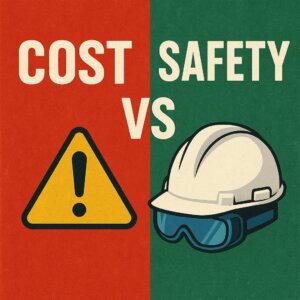Safety standards and compliance requirements are crucial for protecting employees and ensuring workplace safety across different industries. Whether in construction, manufacturing, healthcare, or others, each industry has specific standards and regulations to address unique risks and challenges. This article delves into the safety standards of these industries and provides practical examples for a deeper understanding, helping businesses better comprehend and adhere to relevant requirements.
1. Construction Industry
The safety standards in the construction industry are primarily set by the Occupational Safety and Health Administration (OSHA). Common safety requirements include:
- Protective Equipment: Ensuring that workers wear safety harnesses and helmets when working at heights. According to OSHA, falls from heights account for 33% of all fatalities in the construction industry.
- Site Safety Inspections: Conducting regular safety inspections on construction sites to identify potential hazards. Research shows that regular inspections can reduce accident rates by approximately 20%.
- Accident Reporting: Timely reporting and documenting accidents on-site for analysis and improvement.
Case Study:
In a construction project, a fall accident occurred due to non-compliance with safety protocols, resulting in worker injury. The investigation revealed that regular safety training and inspections could have prevented the incident.
Summary:
Safety standards in the construction industry emphasize protective equipment and site inspections. Effective safety management can significantly reduce the rate of accidents.
References:
2. Manufacturing Industry
The manufacturing industry faces various risks, including machinery injuries and chemical exposure. Key safety standards include:
- Machine Safety: Ensuring that machinery is equipped with safety devices. According to the International Labour Organization (ILO), machinery-related injuries account for approximately 40,000 work-related accidents annually.
- Chemical Management: Adhering to the Globally Harmonized System of Classification and Labeling of Chemicals (GHS) for proper labeling and storage of chemicals.
- Training and Education: Regular safety training for employees to ensure they understand the safety requirements for using equipment and chemicals.
Case Study:
A manufacturing company reduced its injury rate by 50% by implementing a comprehensive safety training program. Employee safety awareness significantly improved, leading to increased productivity.
Summary:
Safety standards in the manufacturing industry focus on equipment safety and employee training. By enhancing employee safety awareness, companies can effectively reduce accident risks.
References:
ILO – Safety and Health in Manufacturing
3. Healthcare Industry
Safety standards in the healthcare industry are concerned with the safety of patients and employees, primarily dictated by healthcare regulations and industry standards. Key requirements include:
- Infection Control: Adhering to strict hygiene standards to prevent cross-contamination. According to the CDC, hospital-acquired infections lead to approximately 70,000 patient deaths annually.
- Occupational Safety: Ensuring healthcare personnel use appropriate personal protective equipment (PPE), such as gloves, masks, and gowns.
- Equipment Safety: Regular checks and maintenance of medical equipment to ensure proper functioning and minimize accidents.
Case Study:
A hospital successfully reduced its infection rate by 30% by reinforcing PPE use and infection control measures, significantly enhancing patient safety and satisfaction.
Summary:
Safety standards in the healthcare industry focus on infection control and equipment safety. Compliance is not only a matter of employee safety but also directly impacts patient health.
References:
4. Food Industry
Safety standards in the food industry are primarily set by the Food and Drug Administration (FDA) to ensure food safety and hygiene. Key requirements include:
- Hygiene Standards: Adhering to strict hygiene regulations to ensure safe food processing and storage.
- Employee Training: Providing regular training on food safety and hygiene for employees.
- Traceability and Recall: Establishing effective food traceability systems to quickly recall products in case of issues.
Case Study:
In a major food company, a rapid-response tracing system successfully recalled contaminated food products, preventing millions in losses and potential consumer harm.
Summary:
Safety standards in the food industry emphasize hygiene management and traceability. Effective tracing mechanisms can swiftly address food safety crises.
References:
5. Chemical Industry
The chemical industry faces risks including chemical leaks and explosions. Key safety standards include:
- Hazardous Material Management: Following strict regulations for chemical storage and usage. According to the American Chemistry Council (ACC), thousands of accidents occur annually due to improper chemical handling.
- Safety Data Sheets: Providing detailed safety data sheets (SDS) for employee reference.
- Emergency Response Plans: Developing contingency plans to address chemical leaks or accidents.
Case Study:
A chemical plant successfully prevented a major environmental disaster by implementing comprehensive crisis management and emergency response plans during a chemical leak incident.
Summary:
Safety standards in the chemical industry emphasize hazardous material management and emergency response. Effective management measures can reduce accident risks.
References:
6. Energy Industry
Safety standards in the energy sector include:
- Equipment Safety: Ensuring all equipment undergoes regular checks and maintenance.
- Operational Safety: Providing necessary training for operators to ensure they understand safety requirements for equipment and processes.
Case Study:
A wind farm successfully prevented accidents through regular maintenance and equipment checks, safeguarding worker safety.
Summary:
Safety standards in the energy industry emphasize equipment and operational safety. Regular checks and training effectively reduce accident risks.
References:
7. Transportation Industry
Safety standards in the transportation industry focus on the safety of drivers and cargo. Key requirements include:
- Driver Training: Ensuring all drivers undergo safety driving training.
- Vehicle Maintenance: Regular maintenance and inspections of transportation vehicles.
- Hazardous Material Transport: Adhering to regulations regarding the transportation of hazardous materials.
Case Study:
A transportation company reduced its traffic accident rate by 40% by implementing strict driver health checks and training.
Summary:
Safety standards in the transportation industry emphasize driver training and vehicle maintenance. Increasing driver safety awareness can significantly reduce accidents.
References:
8. Oil and Gas Industry
Safety standards in the oil and gas industry are stringent to address high-risk operations. Key requirements include:
- Equipment Safety: Regular inspections and maintenance of drilling and production equipment.
- Leak Monitoring: Implementing real-time monitoring systems to detect and address leaks promptly.
Case Study:
An oil company successfully averted a potential environmental crisis through a real-time leak monitoring system, preventing a major accident.
Summary:
Safety standards in the oil and gas industry focus on equipment safety and leak monitoring. Real-time surveillance effectively mitigates safety risks.
References:
API – Safety and Environmental Services
9. Mining Industry
Safety standards in the mining industry aim to address risks in underground and surface operations. Key requirements include:
- Ventilation Systems: Ensuring proper ventilation in mines to prevent harmful gas accumulation.
- Safety Training: Providing safety and emergency response training for employees.
Case Study:
A mining company reduced its accident rate by 25% by improving ventilation system management and conducting regular safety training.
Summary:
Safety standards in the mining industry focus on ventilation and safety training. Effective management measures significantly reduce accident risks.
References:
10. Conclusion
Understanding safety standards and compliance requirements across different industries is vital for business success. By adhering to these standards, companies can protect their employees and enhance their reputation and compliance. Effective safety management is not only a legal responsibility but also a commitment to employees and customers.
Interactive Section
What specific safety standards and compliance requirements does your industry face? Have you encountered challenges or success stories in your operations? Feel free to share your experiences and insights in the comments section, and let’s discuss how to enhance industry safety standards!








